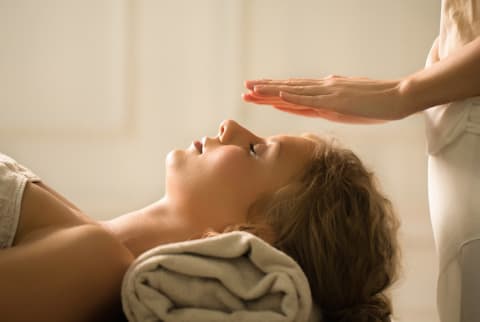Advertisement
Reiki: What It Is + Why You Should Consider Adding It To Your Routine



Over the past year, Reiki has caused some serious buzz in the wellness world. Stars like Gwyneth Paltrow and Christina Aguilera have added the treatment to their self-care repertoires, and it's been featured in mainstream publications like Vanity Fair, Cosmopolitan, and Elle, which called it therapy without words.
Even I, a mindfulness minor, was able to experience the benefits of this ancient practice.
On the surface, Reiki seems like the most holistic of holistic healing techniques. It's founded on the idea that there is unseen energy, or chi, running through everything on earth. Derived from ancient Japanese medicine, Reiki is the process of balancing difficult emotions, relieving stress, and abating physical ailments using subtle movements and touches.
Curious about how a seemingly simple technique could produce such drastic results, I set out to try it for myself. But as I walked into a Reiki session earlier this month, I was slightly skeptical about whether it would "work" on me.
I don’t consider myself a very Zen person. In fact, I can hardly meditate for more than three minutes without thinking about what I want to eat for lunch. I'm always the first one to duck out of an ommmm in yoga class. My visualization technique could use some work. I recognize the value of mindful, holistic practices, but I’ve never been able to quiet my thoughts for long enough to make them a part of my daily routine.
My concern turned out to be totally unfounded. Even I, a mindfulness minor, was able to experience the benefits of this ancient practice.
What Is Reiki?
Stagnant, low levels of chi in the body are thought to indicate physical malaise, while high levels of free-flowing chi imply strength and well-being. Reiki practitioners are trained to channel the energy of their surroundings to balance the energy of their clients.
"Reiki is a gentle way to balance the mind, body, and spirit," Christina Morris, founder and co-owner of Element, explained in an email. "Reiki practitioners lightly place their hands on or just above the body to facilitate the energetic flow and balance in the client to promote better health and well-being."
My introduction to the technique took place in a renovated bank vault (needless to say, I was in Brooklyn) — a cozy, dimly lit space filled with soft music and candles. My practitioner, Corinne Feinberg, asked about my stress and energy levels and then had me lie faceup on the table in the room's center.
What to Expect When You Get a Reiki Treatment
We started with a guided meditation practice — Corinne told me to take deep breaths and relax into the position. Then, she moved her hands to press gently over my chest and shoulder. After a few moments passed, my body actually started to feel heavier. It was filled with warmth, almost like it had gone numb. This lack of physical sensation translated to an isolation of my thoughts, and I was able to completely focus on the patterns in my breathing.
As I went deeper and deeper into the practice, I actually fell asleep for a minute before twitching out of it. I recollected my thoughts and realized that, although Corinne had moved her hands down to my legs, I still felt like she was pressing lightly over my chest and shoulder — a sensation she later told me was called "phantom hand."
She said that people often feel like there are multiple practitioners working on them, when in reality there's only one. This is thought to be the result of our internal energy traveling to where it's most needed in the body. By the end of my 60-minute session, I felt like there were at least four people gently pressing down on me, and I was slow to come out of my daze as Corinne called me back into reality.
I'd recommend a Reiki treatment to anyone looking to see what it feels like to leave your body and live in the mind for a bit.
How I Felt After My First Treatment
The session left me feeling relaxed and more attuned to my thoughts, and I was curious about the benefits of an extended Reiki regimen. Corinne told me that increased self-awareness and emotional sensitivity, decreased stress, and renewed energy were a few of the positive effects of regular treatment (once every two weeks or so).
"Reiki energy flows where it is most needed to balance and restore anything that is not in harmony within a person's being — physically, mentally, emotionally, and spiritually — and heals parts where life force energy has been affected," she further explained in a recent email.
Corinne also spoke to the physical healing effects of Reiki and said that many patients had come to her for help coping with painful diseases like Lyme. Our internal energy, she claimed, is an honest and unimpeded force.
“There is a whole brain that lives below the eyebrows, and it doesn't second-guess things. It just knows," she said as she led me out of the studio.
A statement that might not have resonated with me an hour before, it suddenly made good sense.
Want to experience this same Reiki healing on your own, at home? mindbodygreen’s Reiki Healing 101 class will help guide you every step of the way.